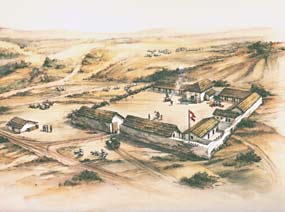
The Presidio exhibit related to the Andy Goldsworthy piece related much of the history of the site, along with Goldsworthy's interpretation. The story is quite interesting - more here (http://www.presidio.gov/experiences/spire.htm). To paraphrase, several species of the originally planted trees have been dying for various reasons, including climate, species selection, and soil conditions. Recently, the organization which oversees the Presidio has been planting new batches of trees to replace those dying - a new 2 to 3 acres of trees are planted each year to stagger the age of the growth and maintenance requirements.
Several articles I have read about this project since the trip speak of the "militaristic" alignment of the existing/original trees in the park. Apparently the army chose to plant trees in a grid, and this practice is being continued. From what I witnessed, the 2-3 acres being planted each year seem to follow with large swaths of single species. Given my brief experience in landscape architecture, I find this curious when current practices greatly discourage monocultures. I would like to dig up more information about what ecologists and arborists think about the Presidio from the standpoint of biodiversity. On the other hand, the aesthetic effect of the grids of plantings surrounding Goldsworthy's 'Spire' of matured and fallen trees is a powerful one.











